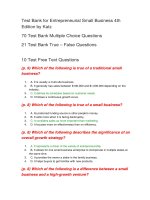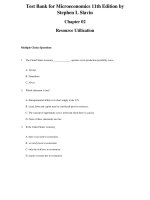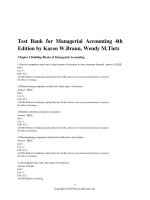Link full download test bank for entrepreneurial small business 4th edition by katz and green
Bạn đang xem bản rút gọn của tài liệu. Xem và tải ngay bản đầy đủ của tài liệu tại đây (558.94 KB, 101 trang )
Test Bank for Entrepreneurial Small Business
4th Edition by Jerome Katz and Richard P.
Green
Chapter 02
Small Business Entrepreneurs: Characteristics and
Competencies
True / False Questions
1. There is one specific pattern of entrepreneurial behavior or entrepreneurial
type. True False
2. Passion is displayed by being persistently focused on the
business. True False
3. Opportunistic planners always plan around the most important aspect of the business first,
act on it, and then consider if additional plans are needed.
True False
4. Habit-based planners don't plan, and they don't even tend to react to changes in
their environments.
True False
5. A situation that occurs when businesses have founders or owners who are passionate about
one or two of the key business functions, such as sales, operations, accounting, finance, or
human resources is known as expert business professionalization.
True False
6. Most successful entrepreneurs exhibit hard work, but completely lack in
competencies. True False
7. The competency suggested by exchange relates to the organizational and business
processes of a firm called basic business competency.
True False
8. Skills necessary to identify and exploit elements of the business environment that can lead
to a profitable and sustainable business are called opportunity competencies.
True False
9. Succession challenges rarely affect family
businesses. True False
10. One of the major challenges identified for family businesses is role
conflict. True False
11. Only one-third of family-owned businesses survive beyond the first
generation. True False
12. Succession plans deal with the people who will take over, what roles they will fill,
and what supports they will receive.
True False
13. One way to maximize communication in the succession process is to create a family
council. True False
14. In family-owned businesses, the board of members can only be comprised of family
members. True False
15. The best way to handle ownership problems is to come out right at the start and
specify or negotiate who owns what.
True False
16. The slowest growing sector of all U.S. businesses is women-owned
businesses. True False
17. Access problems for women- and minority-owned small businesses crop up most
often as discrimination in marketing.
True False
18. For corporations, certification for businesses owned by women or minority is
handled by organizations that are not affiliated with the government or big business.
True False
19. About a third of the retirees who return to work decide to become self-employed.
True False
20. One of the major issues identified for late career entrepreneurs is keeping personal finances
out of the business.
True False
Multiple Choice Questions
21. Cognition:
A. is a person's way of perceiving and thinking about his or her experience.
B. refers to successful entrepreneurial behavior that leads to the creation of a new firm.
C. pertains to the feeling of being absorbed by the tasks and concerns of the business.
D. does not help in making any managerial decisions.
22. The visible behavior a person takes is known as:
A. promotion.
B. perception.
C. action.
D. cognition.
23. Which of the following is one of the most common behaviors found in successful entrepreneurs?
A. Preemption
B. Frigidness
C. Personalization
D. Passion
24. Which of the following is best thought of as a type of learned optimism
in successful entrepreneurs?
A. Apathy
B. Professionalization
C. Perseverance
D. Cognition
25. _____ is the ability to stick with some activity even when it takes a long time, and when
a successful or unsuccessful outcome is not immediately known.
A. Compatibility
B. Competence
C. Sustenance
D. Perseverance
26. The problem behavior of trying the same action repeatedly without learning is called _____.
A. perseveration
B. prevention focus
C. effectuation
D. critical observation
27. Regulatory focus is a mix of _____ focus and _____ focus.
A. effectuation; comprehension
B. comprehension; prevention
C. effectuation; promotion
D. promotion; prevention
28. A(n) _____ focus refers to an entrepreneur's attention on maximizing gains
and pursuing opportunities likely to lead to gains.
A. comprehension
B. promotion
C. effectuation
D. prevention
29. A(n) _____ focus refers to an entrepreneur's attention to minimizing losses, with a
bias toward inaction or protective action to avert loss.
A. external
B. promotion
C. effectuation
D. prevention
30. Which of the following approaches yields better results in an established industry or a poor one?
A. External focus
B. Effectuation focus
C. Prevention focus
D. Promotion focus
31. Which of the following approaches yields better results in richer, dynamic,
uncertain environments or industries?
A. Promotion focus
B. External focus
C. Effectuation focus
D. Prevention focus
32. Entrepreneurs who develop long-range plans for all aspects of the business are known as _____.
A. critical-point planners
B. opportunistic planners
C. comprehensive planners
D. reactive planners
33. Christopher is a hard-working entrepreneur who looked into all the details of his small gaming
software business. He focused on all aspects of the business from the initial launch,
promotion, and marketing aspects to the final set up. He finds planning convenient and works
according to a plan. Christopher is a(n) _____.
A. opportunistic planner
B. habit-driven planner
C. reactive planner
D. comprehensive planner
34. Entrepreneurs who develop plans focused on the most important aspect of the business
first are known as _____.
A. critical-point planners
B. opportunistic planners
C. comprehensive planners
D. reactive planners
35. Which among the following is a critical-point planner?
A. Amanda does not have a very long-term approach to planning and she plans only
for those business aspects that are of paramount importance.
B. Andrew looks at all aspects of the business, from launch to the complete working of it.
C. Cathy looks for a good chance to achieve her goal and acts according to a routine.
D. Joshua acts on what he has been doing and does not believe in planning.
36. Entrepreneurs who start with a goal instead of a plan and look for a chance to achieve
it are known as _____.
A. reactive planner
B. critical-point planner
C. comprehensive planner
D. opportunistic planner
37. Which of the following would have a very short-term approach to planning?
A. Individuals who look for opportunities to achieve their goal, even if the opportunity isn't the
one related to their original goal.
B. Individuals who develop long-range plans for all aspects of the business and act based
on the plans they've developed.
C. Individuals who plan around the most important aspect of the business first, act on it,
and then consider if additional plans are needed.
D. Individuals who are comfortable with planning and act based on the plans they have developed.
38. _____ are completely passive, waiting for cues from the environment to determine what
actions to take.
A. Opportunistic planners
B. Critical-point planners
C. Comprehensive planners
D. Reactive planners
39. Reactive planners:
A. do not react to cues from the environment.
B. take a long-term view and develop long-range plans for all aspects of the business.
C. focus on short-term plans.
D. have fixed goals dictating their efforts.
40. Entrepreneurs who do not plan and prefer to let all actions be dictated by their routines
are known as _____.
A. habit-based planners
B. critical-point planners
C. reactive planners
D. comprehensive planners
41. Which of the following characterizes a habit-based planner?
A. They take a long-term view, develop long-range plans for all aspects of the business, are
comfortable with planning, and act based on the plans they've developed.
B. They plan around the most important aspect of the business first, act on it, and then
consider if additional plans are needed.
C. They are completely passive and generally wait for cues from the environment to
determine what actions to take.
D. They don't plan, and they don't tend to react to changes in their environments.
42. Which of the following planners do best in terms of getting a start-up launched, keeping it
going, and making a living from it?
A. Comprehensive planners
B. Habit-based planners
C. Opportunistic planners
D. Reactive planners
43. Which of the following kinds of planners generally tend do very poorly in business, even if
they do manage to get their firms started?
A. Comprehensive planners
B. Habit-based planners
C. Opportunistic planners
D. Critical-point planners
44. The extent to which a firm meets or exceeds the standard business practices for its
industry is known as _____.
A. bootstrapping
B. professionalization
C. effectuation
D. Perceived Organizational Support (POS)
45. A business action that has been widely adopted within an industry or occupation is known as
_____.
A. best business practice
B. specialized business professionalization
C. standard business practice
D. expert professionalization
46. Which of the following refers the three levels of professionalization?
A. Low, medium, and high
B. Company, industry, and global
C. Personal, team, and organizational
D. Expert, specialized, and minimalized
47. A situation that occurs when all the major functions of a firm are conducted according
to the standard business practices of its industry is known as _____.
A. expert business professionalization
B. specialized business professionalization
C. minimized business professionalization
D. maximized business professionalization
48. Expert business professionalization is a situation that occurs:
A. when only the most critical aspect of business is met.
B. when most aspects of the business meet or exceed the industry's standards.
C. when one or two aspects of the business are met.
D. when none of the business can achieve the industry standard.
49. A situation that occurs when businesses have founders or owners who are passionate about
one or two of the key business functions, such as sales, operations, accounting, finance, or
human resources is known as _____.
A. expert business professionalization
B. specialized business professionalization
C. minimized business professionalization
D. maximized business professionalization
50. A situation that occurs when the entrepreneur does nearly everything in the simplest
way possible is known as _____.
A. expert business professionalization
B. specialized business professionalization
C. minimalized business professionalization
D. maximized business professionalization
51. Which of the following is true with regard to minimalized business professionalization?
A. The entrepreneur does nearly everything in the simplest way possible.
B. The entrepreneur is passionate about one or two of the key business functions.
C. The entrepreneur meets or exceeds the industry's standards.
D. The entrepreneur brings the highest levels of trust among customers.
52. Competencies are defined as:
A. forms of business-related expertise.
B. forms of personal development model.
C. different forms of self-assessment.
D. different forms of personality theories.
53. Getting the business organized and registered is an example of _____ competency.
A. opportunity
B. resource
C. industry-specific
D. boundary
54. The competency suggested by _____ relates to the organizational and business
processes of a firm.
A. intention
B. resource
C. exchange
D. boundary
55. Key business functions:
A. are skills necessary to identify and exploit elements of the business environment that can
lead to a profitable and sustainable business.
B. are activities that reflects a person's determination to start their business and make it a
success.
C. are certain fundamental activities that all businesses must perform.
D. are business-related activities that are optional for the entrepreneur to perform.
56. Activities common to all businesses such as sales, operations (also called production),
accounting, finance, and human resources are known as _____.
A. key business functions
B. competencies
C. business accreditations
D. business-related expertise
57. Certain businesses demand higher safety related rules. For example, window cleaners that
specialize in high-rise buildings have certain rules and safety protocols. These specific
rules would comprise the _____.
A. specialized business professionalization
B. infant-industry argument
C. industry-specific knowledge
D. key business functions
58. The ability or skill of the entrepreneur at finding expendable components necessary to
the operation of the business such as time, information, location, financing, raw
materials, and expertise is known as_____.
A. basic business competencies
B. resource competencies
C. opportunity competencies
D. determination competencies
59. Which of the following competencies requires the energy and focus needed to bring
a business into existence?
A. Determination competencies
B. Resource competencies
C. Opportunity competencies
D. Basic business competencies
60. Martin runs a successful house painting business. He runs his business out of his garage,
which he got converted into an office space. Martin, who had previously worked as a house
painter in another company had good know-how of how to run a house-painting business. After
a storm destroyed public properties in his neighboring town, he contracted with the mayor of
that town to fulfill any painting jobs required during the town's reconstruction. In order to meet
this demand and expand business, he hired more house painters.
According to the BRIE model, which of the following is an example of Martin's
basic business competency?
A. Martin hiring more house painters to meet demand
B. Martin contracting with the mayor to help paint during reconstruction
C. Martin getting his company registered
D. Martin having prior knowledge of the house-painting business
61. Martin runs a successful house painting business. He runs his business out of his garage, which
he got converted into an office space. Martin, who had previously worked as a house painter in
another company had good know-how of how to run a house-painting business. After a storm
destroyed public properties in his neighboring town, he contracted with the mayor of that town to
fulfill any painting jobs required during the town's reconstruction. In order to meet this demand
and expand business, he hired more house painters.
According to the BRIE model, which of the following provides industry-specific knowledge
to martin?
A. Martin hiring more house painters to meet demand
B. Martin contracting with the mayor to help paint during reconstruction
C. Martin getting his company registered
D. Martin having worked in a house-painting company before starting his own business
62. Martin runs a successful house painting business. He runs his business out of his garage,
which he got converted into an office space. Martin, who had previously worked as a house
painter in another company had good know-how of how to run a house-painting business. After
a storm destroyed public properties in his neighboring town, he contracted with the mayor of
that town to fulfill any painting jobs required during the town's reconstruction. In order to meet
this demand and expand business, he hired more house painters.
According to the BRIE model, which of the following is an example of
Martin's resource competency?
A. Martin hiring more house painters to meet demand
B. Martin contracting with the mayor to help paint during reconstruction
C. Martin setting up the business's office in his garage
D. Martin having prior knowledge of the house-painting business
63. Martin runs a successful house painting business. He runs his business out of his garage,
which he got converted into an office space. Martin, who had previously worked as a house
painter in another company had good know-how of how to run a house-painting business. After
a storm destroyed public properties in his neighboring town, he contracted with the mayor of
that town to fulfill any painting jobs required during the town's reconstruction. In order to meet
this demand and expand business, he hired more house painters.
According to the BRIE model, which of the following is an example of
Martin's opportunity competency?
A. Martin hiring more house painters to meet demand
B. Martin contracting with the mayor to help paint during reconstruction
C. Martin setting up the business's office in his garage
D. Martin deciding to set up his own business after quitting his previous job
64. Which of the following deals with the actual process of exploiting an opportunity for profit?
A. Resource
B. Exchange
C. Intention
D. Boundary
65. Which of the following relates to the skills necessary to identify and exploit elements of
the business environment that can lead to a profitable and sustainable business?
A. Determination competencies
B. Basic business competencies
C. Resource competencies
D. Opportunity competencies
66. Which of the following comprises a family business?
A. A firm in which two or more families own a stake in a company but with no authority for daily
management
B. A firm in which no family members are involved in the management of the business
C. A firm in which two or more families are involved in the occasional management of
the business
D. A firm in which one family owns a majority stake
67. Which of the following is a major economic force, employing 58 percent of
America's total workforce?
A. Public companies
B. Government enterprises
C. Family businesses
D. International assignments
68. Which of the following is true as an advantage of businesses run by a group of tight-knit
family members?
A. Succession issues don't crop up in family-owned businesses.
B. Role conflicts never happen in family owned businesses.
C. Board of members is not used in family-owned businesses.
D. Communication-based integration is most effective in family-owned business.
69. Which of the following challenges is typical to family businesses?
A. Motivation and nepotism
B. Role conflict and succession
C. Succession and finances
D. Leadership and finances
70. Which of the following best describes the problem that arises when people have
multiple responsibilities and each makes different demands on them?
A. Role conflict
B. Succession issues
C. Strategizing challenges
D. Leadership constraints
71. Which of the following is the most effective approach for avoiding role conflict?
A. Keep family issues out of the family business
B. Keep separate rules for family members and employees
C. Have constant role reversals
D. Have decisions narrowed down for family members based on family necessities
72. Which of the following problems is closely related to role conflict?
A. Resource shortage
B. Lack of skills
C. Shortage of time
D. Perseverance
73. The organizing process to help make the most efficient use of the day is known as _____.
A. promotion focus
B. competence
C. certification
D. time management
74. Only _____ of family-owned businesses survive beyond the first generation.
A. three-quarters
B. one-half
C. one-fourth
D. one-third
75. ____ refers to the process of intergenerational transfer of business.
A. Role conflict
B. Succession
C. Certification
D. Access
76. Which of the following statements is true about a family council?
A. It helps to maximize communication in the succession process of family businesses.
B. Its main function is complete the key business activities of a family business.
C. It includes family members with immediate interests in the business and a significant
number of non-family members.
D. It is not a good forum for grappling with issues like role expectations, commitment,
and personal responsibility.
77. Which of the following organizations tracks experts in family business?
A. Association for Family Business Foundations
B. Association for Small Business Entrepreneurs
C. Family Business Management Institute
D. Family Firm Institute
78. Which of the following statements about entrepreneurial teams is true?
A. Most entrepreneurial teams are family related.
B. The majority of new businesses have an entrepreneurial team of a minimum five co-owners.
C. The trend is toward even more businesses being developed by a solo entrepreneur.
D. Only 10 percent of teams are spouses or life partners working together.
79. Which of the following is true with regard to women in small businesses?
A. Women-owned businesses are the slowest growing sector of all U.S. businesses.
B. Women-owned firms accounted for 25 percent of small business revenue nationally.
C. Women prefer less-risky firms, which also tend to be firms with lower returns.
D. Women prefer more high-tech firms, as well as firms where technology is central
to the business than men.
80. Qualification for _____ requires certification as a business owned and operated by a woman
or a minority.
A. set-asides
B. codicils
C. product liability insurance
D. professional liability insurance
81. Which of the following is true with regard to minorities in small businesses?
A. Minority-owned firms have not grown much in recent years and are a slow growing sector.
B. The establishment of both public and private funding and networking initiatives has
helped to level the business playing field for minority entrepreneurs.
C. There is a phenomenal decline in the number of minority entrepreneurs despite the
growth of racial and ethnic groups within the U.S. population.
D. Minority entrepreneurs do not face the challenge of access anymore.
82. The two fastest growing minority groups that represent the largest segments of
minority business owners are:
A. Hispanics and African Americans.
B. Hispanics and Pacific Islanders.
C. Asians and African Americans.
D. Asians and Pacific Islanders.
83. The challenge of _____ refers to when woman or minority-owned businesses are
simply excluded from the opportunities offered to firms owned by white males.
A. consistency
B. access
C. flexibility
D. mutuality
84. Identify the simplest form of discrimination with regard to women and minority entrepreneurs
within the U.S. population.
A. Certification
B. Role conflict
C. Access
D. Collusion
85. Access problems for women- and minority-owned small businesses crop up most often as:
A. differences in labeling.
B. discrimination in financing.
C. problems involved in business contacts.
D. the presence and absence of certain skills.









